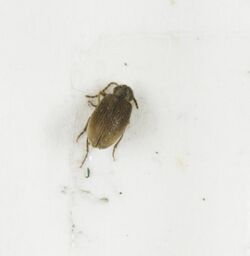Biology:Ptinus tectus
| Ptinus tectus | |
|---|---|

| |
| Scientific classification | |
| Domain: | Eukaryota |
| Kingdom: | Animalia |
| Phylum: | Arthropoda |
| Class: | Insecta |
| Order: | Coleoptera |
| Family: | Ptinidae |
| Genus: | Ptinus |
| Species: | P. tectus
|
| Binomial name | |
| Ptinus tectus Boieldieu, 1856
| |
| Synonyms | |
| |
Ptinus tectus, often called the Australian spider beetle, is a species of beetle in the family Ptinidae,[1] or family Anobiidae, subfamily Ptininae.[2] It is a cosmopolitan species (arrived in Europe and the UK from Australia in 1900). It is a pest of stored foods and museum specimens.
P. tectus Boieldieu, 1856 is the name most often used for this species. Some works still state Ptinus ocellus Brown, 1929.[3]
Biology
Description
The Australian spider beetle (Pictus tectus) measures 2.5–4 mm in length and is coloured dark brown. The adults have biting mouthparts, a well developed thorax and 11-segmented antennae. Characteristics which give them a spider-like appearance include a stout body, pronounced constriction of the neck shield and 6 long thin legs with 5-segmented tarsi.[4]
Life cycle
The female Australian spider beetle lays 100–120 sticky eggs over a period of 4–5 weeks in early summer, either singly or in small batches. At 20–25 °C the eggs hatch in 3–16 days, producing larvae which are fleshy, curved, covered with fine hairs and relatively immobile. Larval development takes at least 6 weeks, during which time the larvae moult 4 or 5 times. When mature, they wander in search of a pupation site where they spin a cocoon cell in which to pupate. Adults emerge after 20 to 30 days and will live for as long 12 months.[4]
At 70% R.H. development of Ptinus tectus from egg laying to emergence from the cocoon takes an average of about 62 days at 23–25 °C; at 15 °C the time taken is about 130 days. The minimum temperature at which complete development can occur is 10 °C and the maximum is between 28 and 30 °C. Considerable mortality occurs in eggs and larvae at 28 °C.[5]
Domestic pest
The species is considered as a pest in museums.[6] It is recorded from at least 55 museums and historic houses in the United Kingdom .[7]
References
- ↑ "Ptinus tectus Boieldieu, 1856". BioLib.cz. https://www.biolib.cz/en/taxon/id9945/. Retrieved 2017-01-25.
- ↑ "Ptinus (Tectoptinus) tectus Boieldieu 1856". Fauna Europaea. 2000–2015. http://www.faunaeur.org/full_results.php?id=100445. Retrieved 2017-01-25.
- ↑ "ITIS - Report: Ptinus ocellus". https://www.itis.gov/servlet/SingleRpt/SingleRpt;jsessionid=2784678C5AB8A6C2DE47789FDC5296C6?search_topic=TSN&search_value=697005#null.
- ↑ 4.0 4.1 "Australian Spider Beetle: Ptinus tectus". PestWeb. http://agspsrv34.agric.wa.gov.au/ento/pestweb/Query1_1.idc?ID=-1781410566. Retrieved 2015-08-31.
- ↑ Ewer, D. W.; Ewer, R. F. (1942). "The biology and behaviour of Ptinus tectus Boie.(Coleoptera, Ptinidae), a pest of stored products. III. The effect of temperature and humidity on oviposition, feeding and duration of life cycle". Journal of Experimental Biology 18: 290–305. doi:10.1242/jeb.18.3.290.
- ↑ Pinnager, D. 2001. Pest Management in Museums, Archives and Historic Houses. Archetype Publications.
- ↑ "Whats Eating Your Collection?". Collections Trust. 2015. http://www.whatseatingyourcollection.com/recordings.php?grouping=7. Retrieved 2015-07-22.
External links
- Padil Diagnostic images (as P. ocellus Brown, 1929)
- Ptinus tectus UK distribution at National Biodiverity Network Gateway
- Ptinus tectus images at Coleoptera.org
Wikidata ☰ Q659578 entry
 |

